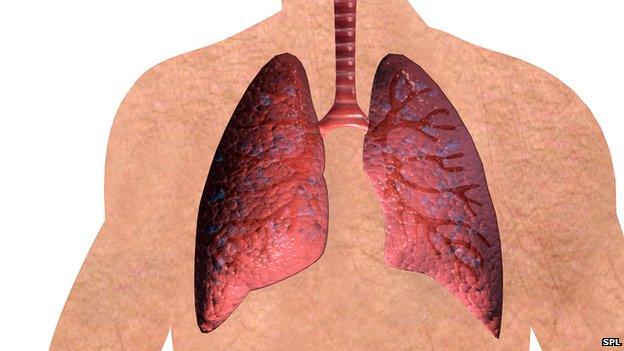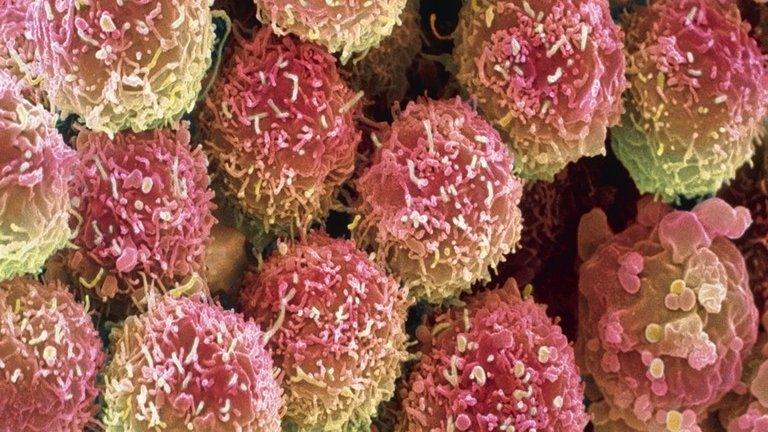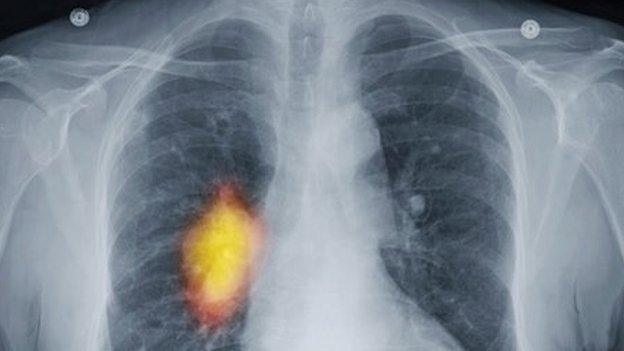Lung cancer survival stats reveal poor outlook
- Published

Half of people with lung cancer die within six months of diagnosis, says a report from Macmillan Cancer Support which looked at variations in cancer survival rates.
While breast cancer and prostate cancer have a five-year survival rate of more than 80%, lung cancer's is around 10%.
Those who survive lung cancer for five years are then 10 times more likely to get another cancer.
Macmillan said improving early diagnosis was key.
In their report, the cancer charity carried out an analysis of almost 85,000 cancer patients' experiences of the NHS in England from 2004 to 2011.
They looked in detail at what happened to people with one of four types of cancer - breast, prostate, lung or brain cancer - after they were diagnosed.
Good health?
The research showed that one in five (20%) women with breast cancer and one in four (25%) men with prostate cancer survived for at least seven years after diagnosis in good health.
But the picture was significantly worse for people with lung cancer, or the most common form of brain cancer, of whom less than 1% survived long-term and in good health.
The report suggests that one in five people with lung cancer die within one month of being diagnosed and 73% die within one year.
Although survival rates for some cancers "have soared" over the past 40 years in England, the report says other cancers are lagging behind and the figures make the case for improving cancer care across the UK more urgent.
In its report, Cancer's unequal burden, external, Macmillan Cancer Support urges NHS leaders and GPs to plan cancer services better, improve early diagnosis and provide the best treatment available regardless of age or location.
'Biggest killer'
Ciaran Devane, chief executive of Macmillan Cancer Support, said the findings revealed "stark variations".
"Cancer is not just one disease, and therefore there is no one-size-fits-all approach to treatment and aftercare.
"The NHS needs to get much better at using robust data to understand the complex needs of people with different cancers so that services can be planned accordingly. It's no good papering over the cracks any longer, we need a complete system overhaul."
Dr Penny Woods, chief executive of the British Lung Foundation, said the report made an important call for improvements in early diagnosis.
"Late presentation and diagnosis is one of the main reasons lung cancer survival rates in this country lag so far behind rates in Europe and the US, as well as rates for other cancers. As such, the report's revelation that over half of lung cancer patients die within just six months of diagnosis is sadly very telling."
Dr Woods said evidence suggested that public awareness campaigns were starting to increase early diagnosis rates.
But she added: "It is no coincidence that survival rates are so much greater for the likes of breast cancer, given the amount of research funding allocated to such areas have long dwarfed the amount given to lung cancer.
"Lung cancer is by far the biggest cancer killer in this country: it's time we stopped treating it like the poor relation."
Most cases of lung cancer are related to smoking, which is the biggest risk factor for the disease.
Although rates of lung cancer are decreasing in men, they are rising in women because of the number of women who continued to smoke during the post-war period and into the 1970s.
- Published20 March 2014

- Published20 March 2014

- Published24 January 2014
